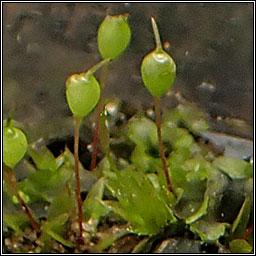
br-178a1.jpg from: https://www.dorsetnature.co.uk/pages-bry/br-178.html
Exploring the Fascinating World of Physcomitrium cyathicarpum Mitt. Moss
Mosses are small but mighty plants that play crucial roles in ecosystems around the world. One particularly interesting species is Physcomitrium cyathicarpum Mitt., a member of the Funariaceae family. Also known simply as Physcomitrium, this diminutive moss packs a big punch when it comes to ecological importance and scientific intrigue. Let’s take a closer look at this captivating bryophyte.
Background on Mosses and the Funariaceae Family
Before diving into the specifics of P. cyathicarpum, it’s helpful to understand some background on mosses in general. Mosses are non-vascular plants in the division Bryophyta. They lack true roots, stems, and leaves, instead having structures that serve similar functions. Mosses reproduce via spores rather than seeds and require moisture for sexual reproduction.
The Funariaceae are a family of mosses known as “cord mosses.” They get this name from the twisted seta (stalk) that supports their spore capsules. Members of Funariaceae are found worldwide and occupy a variety of habitats, from disturbed soils to damp, shady spots.
Morphology and Identification of Physcomitrium cyathicarpum
Physcomitrium cyathicarpum is a small, annual moss that forms short turfs. Its leaves are oblong-lanceolate and have a bordered, serrulate margin. The seta is very short, making the capsules appear to sit directly on top of the leaves. Capsules are globose and have a well-developed peristome. Spores are released from the capsule via an operculum that falls off at maturity.
Identifying P. cyathicarpum requires close examination of its microscopic features. However, its distinctive capsule shape and placement can help narrow down the possibilities in the field. It can be distinguished from the similar species P. pyriforme by its leaves, which are broader and have a more pronounced border.
Global Distribution and Habitat
P. cyathicarpum has a wide distribution, being found in Europe, Asia, Africa, Australia, and the Americas. It grows in a variety of habitats, including disturbed soils, river banks, and damp, open areas. This adaptable moss is often one of the first species to colonize bare ground, such as agricultural fields, road embankments, and burnt areas.
In many parts of its range, P. cyathicarpum is considered a pioneer species. It helps stabilize soils and paves the way for other plants to establish. Its ability to tolerate disturbance and quickly colonize bare ground makes it an important component of early successional ecosystems.
Ecological Roles and Adaptations
Like other mosses, P. cyathicarpum plays several important ecological roles:
- Erosion control: Its dense turfs help hold soil in place and prevent erosion.
- Moisture retention: Mosses act as sponges, absorbing and slowly releasing water. This helps regulate moisture levels in the surrounding environment.
- Carbon sequestration: Mosses are significant carbon sinks, storing carbon in their tissues and the soils they help create.
- Habitat provision: Many small invertebrates make their homes among moss cushions.
To survive in its preferred habitats, P. cyathicarpum has several key adaptations:
- Desiccation tolerance: It can survive extended periods of dryness by going dormant and reviving when moisture returns.
- Spore dispersal: Its small, lightweight spores are easily carried by wind to colonize new areas.
- Rapid life cycle: As an annual species, it can quickly establish, reproduce, and spread.
Conclusion
Physcomitrium cyathicarpum may be small, but it is a fascinating and ecologically important moss. From its global distribution to its role as a pioneer species, this mighty moss has much to teach us about resilience, adaptability, and the complex workings of ecosystems.
The next time you spot a patch of moss, take a closer look – you may just be gazing at the incredible P. cyathicarpum! What other secrets might these ancient plants hold?